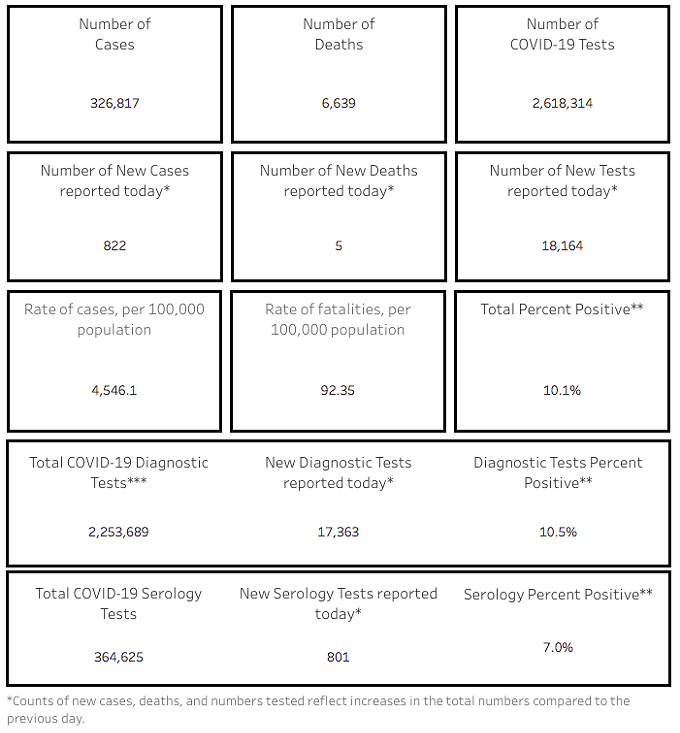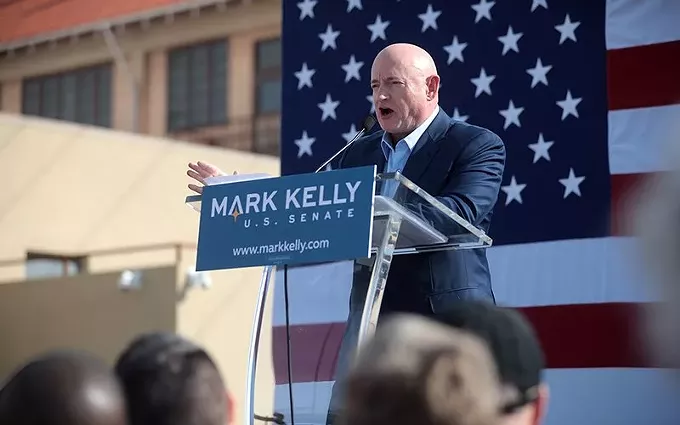Monday, November 30, 2020
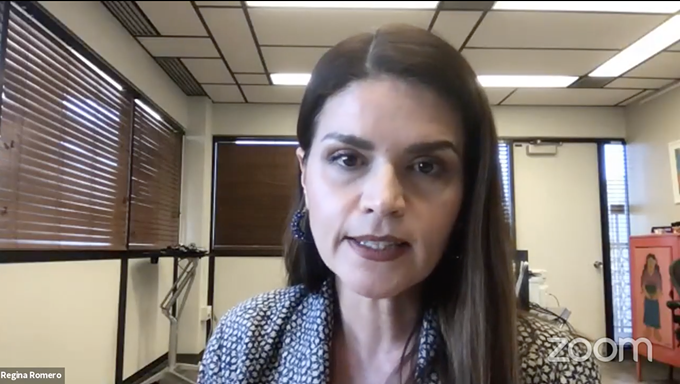
Romero says she’ll be asking the council to consider implementing a mandatory curfew from 8 p.m. to 5 a.m. that would run from Dec. 1 to Dec. 22.
On Nov. 23, the Pima County Health Department announced a voluntary overnight curfew from 10 p.m. to 5 a.m. every day until Dec. 31—but it’s not enforceable.
At 5 p.m. Tuesday, Romero will ask the city’s council members to vote on the mandatory curfew, which if approved, would go into effect three hours later.
- Emergency response personnel
- Traveling to and from work
- Attending religious services
- Caring for a family member
- Seeking medical care
- Fleeing dangerous circumstances
- Traveling to perform or receive essential functions
- Homeless
“We are hoping that this particular measure will help our community, will help slow the surge of cases and preserve precious hospital capacity,” Romero said at the press conference. “We are also hoping that this curfew, that this step, will help prevent a stay-at-home order or a lockdown.”
How would the curfew be enforced?
City Attorney Mike Rankin said the proclamation will be presented to the council Tuesday to describe how the curfew would be enforced.
Before being subject to a citation, those violating the curfew would be notified of the new provision and given the opportunity to comply. If citations are issued, Rankin said his city attorney’s office has the ability to resolve the citations by offering diversion or “some other noncriminal proceedings.”
Rankin said violation of an emergency proclamation issued by a mayor is a misdemeanor offense, but that “the direction as part of the mayor's proclamation...would be that prosecution would include the opportunity for diversion to avoid the criminal sanction.”
If the offender denies the diversion offer, they could face criminal prosecution. Fines for misdemeanor crimes range from as high as $2,500, according to Rankin.
Is it legal to issue a mandatory local curfew?
The city attorney said the legal basis Romero has to issue a curfew is based on the mayor’s right to take action during a local emergency.
“I don't see this as a challenge to the governor's authority, or the authority that is given to him as the executive of the state. In fact, the proclamation certainly leaves room for the governor to execute all of his emergency powers,” Rankin said. “Arizona law and the charter also gives certain authority at the local level. So this isn't a challenge to state authority, but it is using the local authority that is provided under Arizona law to adopt these kinds of measures that are necessary for public health and safety.”
On Monday, Nov. 30, Arizona officials certified the results of the Nov. 3 presidential election, confirming Democrat Joe Biden's win over Republican incumbent Donald Trump. It was a close race in the Grand Canyon State, with Biden earning 49.36% of the vote, over Trump's 49.06%, winning by a little more than 10,000 votes. This is the first time Arizona has voted blue in a presidential election since 1996.
"Of those 3.42 million ballots cast, over 88% of them were cast early, which provides more proof that Arizona's ballot-by-mail system works," said Arizona Secretary of State Katie Hobbs. "Despite unprecedented challenges, Arizonans showed up for our democracy."
Hobbs confirmed the results during The State Canvass, alongside Governor Doug Ducey, Attorney General Brnovich, and Chief Justice Robert Brutinel.
"This election was conducted with transparency, accuracy and fairness, in accordance with Arizona's laws and elections procedures, despite numerous unfounded claims to the contrary," Hobbs said.
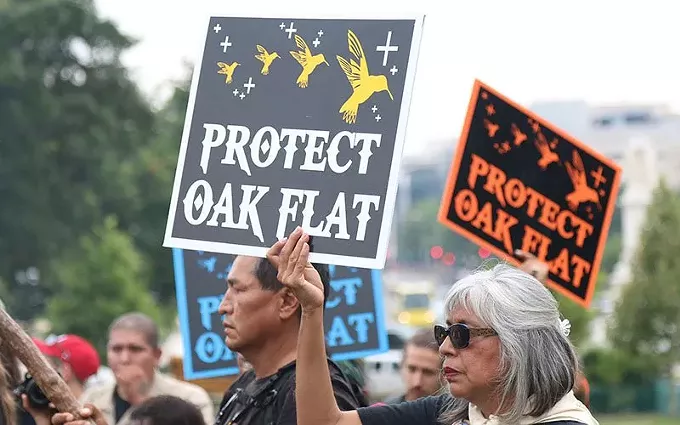
WASHINGTON – Activists worry that the Trump administration has fast-tracked the final environmental impact statement for the massive Resolution Copper mine, a project planned for lands near Superior that are claimed as sacred by the San Carlos Apache.
Opponents became alarmed when the U.S. Forest Service’s schedules of proposed action, which said the environmental statement would be completed by December 2021, suddenly shifted this year to a finishing date of this December, before President Donald Trump leaves office.
“A lot of alarm bells went off when we saw this,” said Randy Serraglio, Southwest conservation advocate at the Center For Biological Diversity. “We realized … they’re just rushing this through to get it done, while Donald Trump is still president.”
But officials with the Forest Service and Resolution Copper mine insist nothing is being fast-tracked.
Ivan Knudsen, a Forest Service spokesman, said more than “30,000 submittals received during the public and tribal comment periods” were cataloged since the last draft of the environmental impact statement was published in August 2019. He stressed that the timeline adjustment from 2021 to 2020 does “not reflect an acceleration of the … process” and that federal and local appraisals are being conducted.
“Once completed, they will be reviewed by the regional appraiser, and after they are accepted, made available to the public for review,” said Knudsen.
Experts from the COVID-19 modeling team at the University of Arizona are calling for a shelter-in-place order, mask mandate and emergency economic relief measures statewide as coronavirus metrics increase to alarming levels.
“No matter what actions are taken, Arizona will experience a hospital crisis in the coming weeks. However, if action is not immediately taken, then it risks a catastrophe on a scale of the worst natural disaster the state has ever experienced,” UA’s COVID-19 modeling team wrote in a memo to the Arizona Department of Health Services. “It would be akin to facing a major forest fire without evacuation orders.”
Dr. Joe Gerald, a professor at UA who creates weekly coronavirus epidemiology reports based on ADHS data, also called for further COVID-19 mitigation tactics as his latest report shows an alarming spread of the virus throughout the state.
“Arizona is experiencing a public health crisis where access to critical care services is limited due to shortages of space, personnel, and critical supplies. If not addressed within the next 2-3 weeks, this crisis will evolve into a humanitarian crisis leading to hundreds of preventable deaths,” Gerald wrote in his latest report. “At this point, only shelter-in-place restrictions are certain to quickly and sufficiently curtail viral transmission.”
According to Gerald's latest update, Arizona likely passed concerning thresholds of 30,000 COVID-19 cases per week and 4,000 cases per day this week.
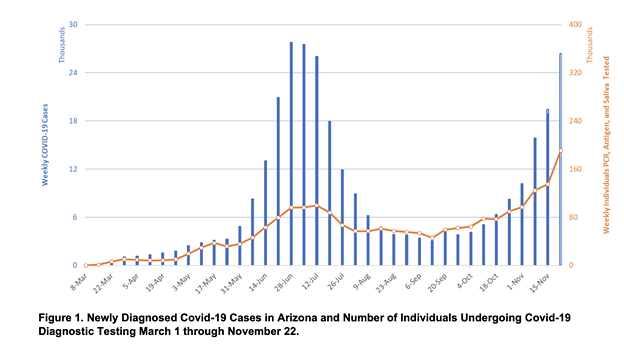
His report says Arizona's COVID-19 test positivity reached 17% the past week, providing “additional evidence that viral transmission continues to increase despite the uncertainty surrounding actual case counts.”
On Friday, Nov. 27, 28% of hospital ward beds were filled by COVID-19 patients, a 24% increase from the week prior. Of the state’s ICU beds, 32% were occupied by coronavirus patients, a 27% increase from last week, according to Gerald’s report.
Members of the COVID-19 modeling team at UA said Arizona State University’s COVID-19 projections predict by early December, hospitalizations will exceed current ICU and general ward capacity throughout the state.
By late December, the ASU COVID-19 modeling team predicts hospitalizations will exceed their total capacity, causing “no additional availability to provide care for routine, urgent, or emergent non-COVID care,” according to the UA modeling team’s memo.
Gerald wrote in his report that if total hospital capacity is reached, “it would represent a humanitarian crisis of unparalleled proportion and would be accompanied by hundreds if not thousands of preventable deaths.”
With more than 800 new cases reported today, the number of Arizona’s confirmed novel coronavirus cases closed in on 327,000 as of Monday, Nov. 30, according to the Arizona Department of Health Services.
Pima County, which reported 46 new cases today, has seen 39,859 of the state’s 326,817 confirmed cases.
With five new deaths reported yesterday, a total of 6,639 Arizonans had died after contracting COVID-19, including 691 deaths in Pima County, according to the Nov. 30 report.
The number of hospitalized COVID cases statewide continues to climb upward as the virus has begun to spread more rapidly, putting stress on Arizona’s hospitals. ADHS reported that as of Nov. 29, 2,513 COVID patients were hospitalized in the state, the highest that number has been since July 27. That number peaked with 3,517 hospitalized COVID patients on July 13; it hit a subsequent low of 468 on Sept. 27.
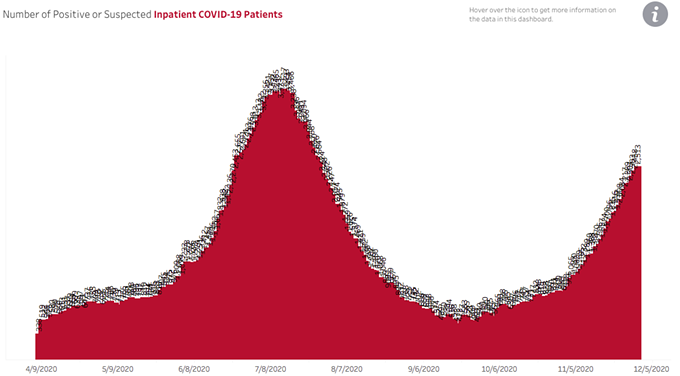
A total of 1,488 people visited emergency rooms on Nov. 29 with COVID symptoms. That number peaked at 2,008 on July 7; it hit a subsequent low of 653 on Sept. 28.
A total of 579 COVID-19 patients were in intensive care unit beds on Nov. 29, the highest that number has been since Aug. 5. The number of COVID patients in ICUs peaked at 970 on July 13 and hit a subsequent low of 114 on Sept. 22.
On a week-by-week basis in Pima County, the number of positive COVID tests peaked the week ending July 4 with 2,452 cases, according to an Nov. 25 report from the Pima County Health Department. (Numbers in this report are subject to revision.)
Pima County is seeing a dramatic rise in cases in recent weeks. For the week ending Oct. 31, 1,348 cases were reported; for the week ending Nov. 7, 2,119 cases were reported; and for the week ending Nov. 14, 2,578 cases were reported; for the week ending Nov. 21, 3,313 cases were reported.
Pima County Administrator Chuck Huckelberry noted last week that the county had seen 4,620 cases in the first 17 days in November.
“For the first 17 days in July, the worst month of COVID-19 case increases to date, there were 5,057 cases,” Huckleberry said in a Nov. 17 memo. “Therefore, we are on pace to exceed the total number of monthly COVID-19 infections in our previous worst month, July.”
WASHINGTON – He won’t be Arizona’s next U.S. senator for another couple of days, but Sen.-elect Mark Kelly is already acting the part.
Just days after Election Day, the Democrat was on Capitol Hill for new member orientation and conversations with sitting senators from both sides of the aisle, including Republicans Mitt Romney of Utah, Marco Rubio of Florida and Pat Toomey of Pennsylvania, his aides said.
He met with Gov. Doug Ducey, unveiled a 13-member transition team and hosted a public briefing about the impact of COVID-19 on Arizonans and the local economy.
But there’s not a lot of time to waste: Because of unusual circumstances of the Senate election in Arizona this year, Kelly could be sworn a full month before the rest of the Senate.
“It’s probably like falling out of the stars and into a place on planet Earth … It’s very fast,” said Bradford Fitch, president and CEO of the Congressional Management Foundation, about Kelly’s quick transition into the Senate seat.
On Monday, Ducey and Secretary of State Katie Hobbs are required to certify the results of the Nov. 3 election, which gave Kelly a 51.2-48.8% margin over Sen. Martha McSally, R-Arizona. More than 3.3 million votes were cast in the election, which capped the most-expensive Senate race in state history.
Kelly and McSally were facing off in a special election to fill the remainder of late Sen. John McCain’s term, which McSally was appointed to fill temporarily in 2018. Because it’s a special election, Kelly can be sworn as soon as election results are certified.
McSally smoothed the way two weeks ago when she conceded to Kelly, and in her farewell address to the Senate last week when she wished him well.
Friday, November 27, 2020
PHOENIX – As cases of COVID-19 continue to surge in Arizona and the rest of the nation, the state’s three public universities are wrangling their approaches to the pandemic in similar but separate ways.
Arizona State University developed a saliva-based test and aims to monitor the spread through frequent mass testing.
The University of Arizona, unlike its counterparts, invested in a wastewater test to monitor the spread in highly populated places on campus and suggested a schoolwide shelter-in-place initiative.
Northern Arizona University, the smallest of the three, has changed the least. It adopted ASU’s saliva test and shares UArizona’s system for contact tracing, but it has been the most lenient with in-person education, offering classes with fewer than 45 students.
As the end of the semester nears, holiday travel ramps up and the pandemic reaches a critical juncture, college campuses and their thousands of students are being further scrutinized.
All three Arizona universities will end all in-person classes after the Thanksgiving holiday and recommended students and faculty get tested before any holiday travel and before they return in the spring.
As of Tuesday, Nov. 24, the Arizona Department of Health reported 4,544 new cases with a percent positive rate of 9.9%. In Maricopa County, which includes four of ASU’s campuses, the positivity rate exceeded the state average by nearly 1%.
Nationally, there have been more than 12 million cases of COVID-19 and more than 1 million cases in the past seven days alone, according to the Centers for Disease Control. Johns Hopkins University reports a national seven-day percent positive rate of 9.6%.
“They’re using their strengths,” Will Humble, executive director for the Arizona Public Health Association, said of the slight differences in approaches among Arizona campuses. “But in the end it will be really interesting to see (when) we can look back at the three universities and compare their outcomes and we’ll be able to tell which approaches were most effective.”
Humble said it is too early to draw definitive conclusions, but he praised each university for acting fast.
Six days after President Donald Trump lost his bid for reelection, the U.S. Department of Agriculture notified food safety groups that it was proposing a regulatory change to speed up chicken factory processing lines, a change that would allow companies to sell more birds. An earlier USDA effort had broken down on concerns that it could lead to more worker injuries and make it harder to stop germs like salmonella.
Ordinarily, a change like this would take about two years to go through the cumbersome legal process of making new federal regulations. But the timing has alarmed food and worker safety advocates, who suspect the Trump administration wants to rush through this rule in its waning days.
Even as Trump and his allies officially refuse to concede the Nov. 3 election, the White House and federal agencies are hurrying to finish dozens of regulatory changes before Joe Biden is inaugurated on Jan. 20. The rules range from long-simmering administration priorities to last-minute scrambles and affect everything from creature comforts like showerheads and clothes washers to life-or-death issues like federal executions and international refugees. They impact everyone from the most powerful, such as oil drillers, drugmakers and tech startups, to the most vulnerable, such as families on food stamps, transgender people in homeless shelters, migrant workers and endangered species. ProPublica is tracking those regulations as they move through the rule-making process.
Every administration does some version of last-minute rule-making, known as midnight regulations, especially with a change in parties. It’s too soon to say how the Trump administration’s tally will stack up against predecessors. But these final weeks are solidifying conservative policy objectives that will make it harder for the Biden administration to advance its own agenda, according to people who track rules developed by federal agencies.
“The bottom line is the Trump administration is trying to get things published in the Federal Register, leaving the next administration to sort out the mess,” said Matthew Kent, who tracks regulatory policy for left-leaning advocacy group Public Citizen. “There are some real roadblocks to Biden being able to wave a magic wand on these.”
In some instances, the Trump administration is using shortcuts to get more rules across the finish line, such as taking less time to accept and review public feedback. It’s a risky move. On the one hand, officials want to finalize rules so that the next administration won’t be able to change them without going through the process all over again. On the other, slapdash rules may contain errors, making them more vulnerable to getting struck down in court.
The Trump administration is on pace to finalize 36 major rules in its final three months, similar to the 35 to 40 notched by the previous four presidents, according to Daniel Perez, a policy analyst at the George Washington University Regulatory Studies Center. In 2017, Republican lawmakers struck down more than a dozen Obama-era rules using a fast-track mechanism called the Congressional Review Act. That weapon may be less available for Democrats to overturn Trump’s midnight regulations if Republicans keep control of the Senate, which will be determined by two Georgia runoffs. Still, a few GOP defections could be enough to kill a rule with a simple majority.



